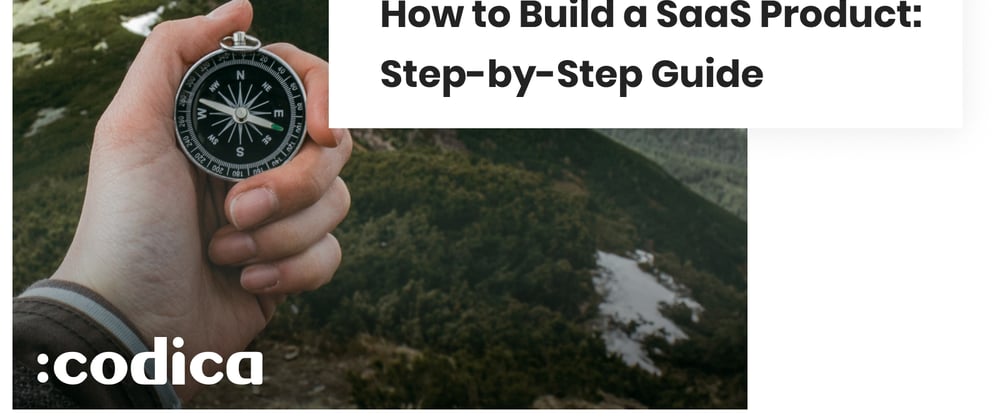This article was originally published on Codica Blog.
Over the last years, cloud computing has been growing steadily. Cisco Annual Internet Report only proves this fact. It predicts that 75% of the total cloud workloads and compute instances will be in the form of SaaS by 2022.
In this post, we will discuss the process of building a software-as-a-service product. Being a custom software development company, we will eagerly share our insights into custom SaaS development.
Step 1. Conduct market analysis
First, you need to check the feasibility of your business idea. Market research will help you solve this task.
Below you can see the most important things that you should define in the first place:
- Potential customers;
- The main pain points of your target audience;
- Competitors;
- Unique features of similar products;
- Business models.
By conducting the market analysis, you will find out what business opportunities you have. This approach will help you build a SaaS product that will bring the highest value to your customers.
Step 2. Write a detailed business plan
A business plan serves as an essential tool for outlining the primary goals of software-as-a-service product development.
It would include the following points:
How can you distinguish your product from the others?
Define your unique value proposition. Make it short and catchy.What are the main pain points of your potential customers, and how will your project solve them?
Consider what issues you are going to fix with your SaaS product.How are you going to communicate with your target audience?
Choose the right marketing channel. Think of content marketing, social media, advertising.How will you make profit from building a SaaS product?
Determine the most suitable business model.Where do you want to get financial coverage, and how do you want to spend it? Identify the main funding sources and spendings for your project.
What are the goals to be achieved to realize your vision?
Make a list of principal goals for the first few months of your enterprise.
Step 3. Make a list of basic SaaS requirements
Your future SaaS product should satisfy the following requirements:
Multi-tenancy. When it comes to cloud computing, this term means that multiple clients of a particular service provider use the same computing resources. They do not know about each other, and their data is kept separately.
Self-service provisioning. It means that service delivery is established by automated processes. Therefore, it speeds up the whole procedure and makes it more consistent, stable, and scalable.
Enhanced security. SaaS products protect sensitive information from security vulnerabilities. The most common security measures are access control, multi-factor authentication, and identity management.
User activity monitoring. With the help of audit logs, you can track changes, protect your data, and solve integrity and access issues.
Step 4. Define the technical stack that suits your business requirements the best
The technology stack comprises all the programming languages, frameworks, and tools applied in the development of a certain application. These days we have a great variety of technologies to choose from.
Let’s take a closer look at the most suitable technology tools for each aspect of the SaaS development process.
Front-end
Front-end development is responsible for the client-side. Consider using the most advanced modern JavaScript frameworks such as React, Angular, or Vue.js.
At Codica, we prefer React and Vue.js. React is a current market leader. Besides, you should think of Vue.js if you want to build a lightweight and easy-to-maintain app.
Back-end
Back-end development is in charge of the server-side. You need to choose the most reliable programming languages and frameworks. It would be a good idea to choose Ruby on Rails, Node.js, or Django for the back end.
The Codica team makes the Ruby programming language our main technology. We picked Ruby on Rails for being a fast, cost-effective, scalable, and secure framework.
Database
Databases store all the required information for your apps. We suggest choosing PostgreSQL, MySQL, or NoSQL.
Our ultimate choice is PostgreSQL, the most enhanced open-source database.
To handle SaaS requirements, you will need a reliable cloud provider such as Amazon (AWS), Google, Microsoft, or Heroku.
We usually work with Amazon Web Services owing to its reliability, flexibility, and security.
Step 6. Launch a minimum viable product
The proven way to validate your business idea is to create a minimum viable product. In contrast to fully-fledged products, MVP has only very basic features. However, it is enough for attracting pioneer customers and getting their feedback.
The main goals of launching an MVP are:
Collect and analyze feedback. It becomes more clear what functionality you should add, modify, or remove.
Test the waters. You will be able to check whether your application will suit the rapidly growing SaaS market.
Try different concepts. The MVP approach allows measuring the effectiveness of business hypotheses.
Conclusion
We hope that our detailed guide will come in handy if you decide to build a reliable, scalable, and secure cloud application.
For more information on the topic, check our article: How to Build a SaaS Product: Step-by-Step Guide.







Top comments (2)
Fantastic step-by-step guide on SaaS product development! Your insights are spot on. For those diving into the world of tech, this is a must-read on how to make a SaaS product. Thanks for breaking it down so clearly!
Some comments may only be visible to logged-in visitors. Sign in to view all comments. Some comments have been hidden by the post's author - find out more